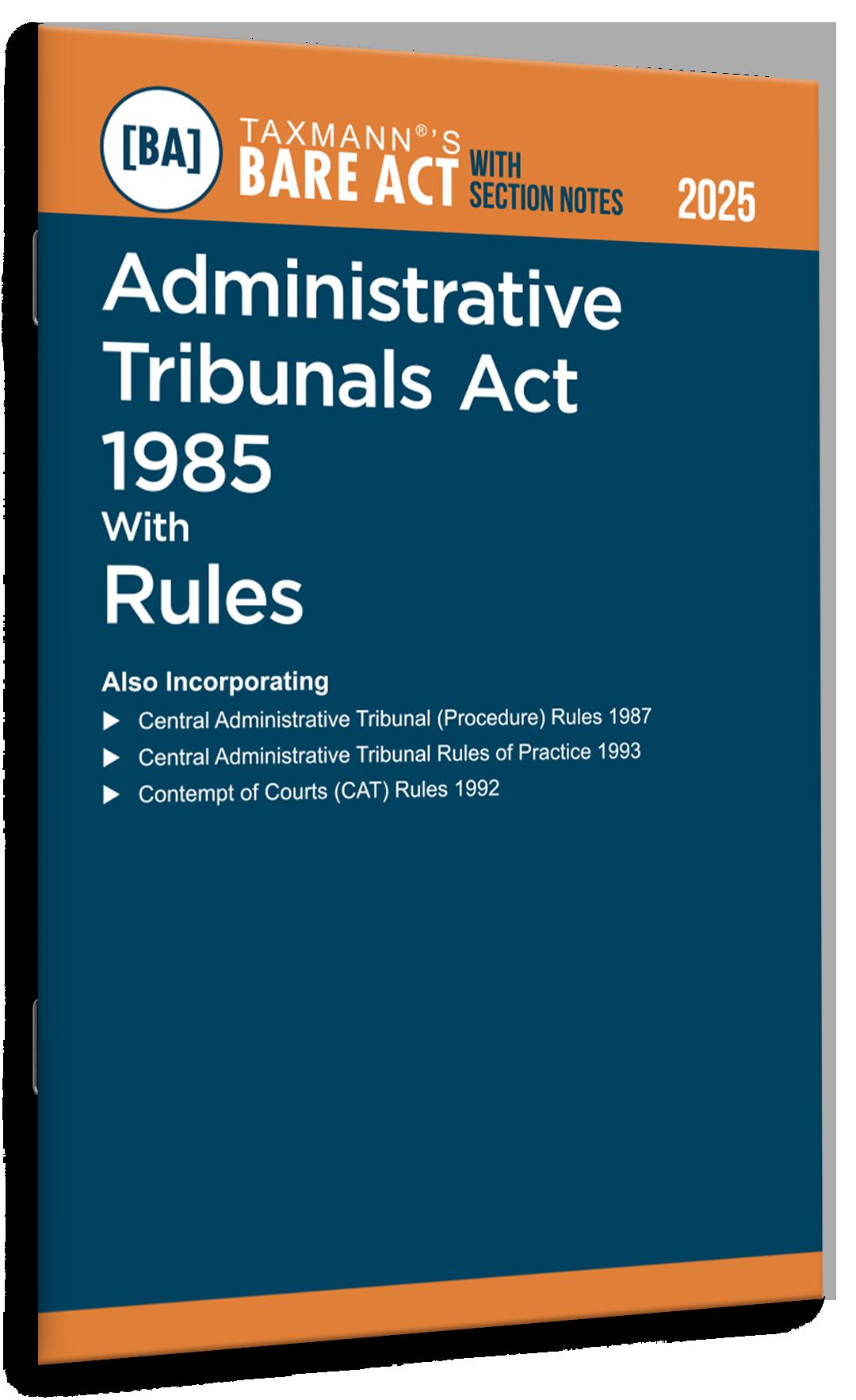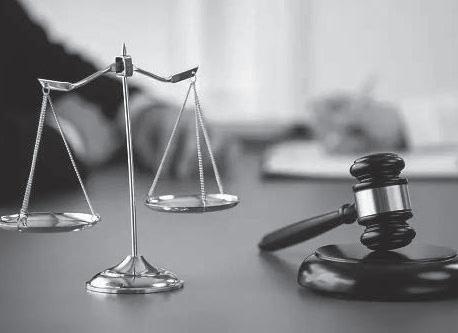
















Form of Register No. 4: Court Diary
Form of Register No. 5: Ready List of OAS/RAS/TAS/CPS (Civil/Crl.)/ P.Ts./M.As.
Form of Register No. 6: Stage Register
Form of Register No. 7:
Form of Register No. 8: Register of Inspection
Form of Register No. 9: Register of
Form
Form
Form of
No. 10:
No. 11:
No. 12: Despatch
No. 13: Register of S.L.Ps/Appeals
No. 14:

An Act to provide for the adjudication or trial by Administrative Tribunals of disputes and complaints with respect to recruitment and conditions of service of persons appointed to public services and posts in connection with the affairs of the Union or of any State or of any local or other authority within the territory of India or under the control of the Government of India or of 1[any corporation or society owned or controlled by the Government in pursuance of article 323A of the Constitution] and for matters connected therewith or incidental thereto.
BE it enacted by Parliament in the thirty-sixth Year of the Republic of India as follows:—
Short title, extent and commencement.
1. (1) This Act may be called the Administrative Tribunals Act, 19852.
(2)It extends—
(a) in so far as it relates to the Central Administrative Tribunal, to the whole of India; (b) 3[***]
(3)The provisions of this Act, insofar as they relate to the Central Administrative Tribunal, shall come into force on such date4 as the Central Government may, by notification, appoint.
1. Substituted for “any corporation owned or controlled by the Government” by the Administrative Tribunals (Amendment) Act, 1986, w.e.f. 22-1-1986.
2. Dated 27-2-1985.
3. Omitted by the Jammu and Kashmir Reorganisation Act, 2019, w.e.f. 31-10-2019. Prior to its omission, clause (b) read as under: “(b) in so far as it relates to Administrative Tribunals for States, to the whole of India, except the State of Jammu and Kashmir.”
4. W.e.f. 1-7-1985 vide Notification G.S.R. 527(E), dated 1-7-1985.
(4) The provisions of this Act, insofar as they relate to an Administrative Tribunal for a State, shall come into force in a State on such 5date as the Central Government may, by notification, appoint.
1.1 Short Title
This Act is called the Administrative Tribunals Act, 1985.
1.2 Extent of the Act
Central Administrative Tribunal (CAT):
The provisions of this Act relating to CAT apply to the whole of India.
State Administrative Tribunals (SATs):
The provision relating to State Tribunals was originally applicable across all Indian states, excluding the (erstwhile) State of Jammu and Kashmir. However, with the enactment of the Jammu and Kashmir
Reorganisation Act, 2019, the exclusion to the Jammu & Kashmir no longer applies from October 31, 2019.
See section 2 of the Act which provides for the Act not to apply to certain persons.
Act not to apply to certain persons.
2. The provisions of this Act shall not apply to—
(a) any member of the naval, military or air forces or of any other armed forces of the Union;
(b) 6[***]
(
c) any officer or servant of the Supreme Court or of any High Court 7[or courts subordinate thereto];
(
d) any person appointed to the secretarial staff of either House of Parliament or to the secretarial staff of any State Legislature or a House thereof or, in the case of a Union territory having a Legislature, of that Legislature.
5. Provisions in its application to State Administrative Tribunal for Andhra Pradesh came into force w.e.f. 1-11-1989, vide G.S.R. 921(E), dated 25-10-1989, for Arunachal Pradesh came into force w.e.f. 3-8-1989, vide G.S.R. 638(E), dated 3-8-1989, for Gujarat, Himachal Pradesh, Karnataka, Kerala, Madhya Pradesh, Maharashtra and Orissa came into force w.e.f. 1-1-1985, vide Notification No. G.S.R. 956(E), dated 31-12-1985, for State of Bihar came into force w.e.f. 22-10-1991, vide S.O. 715(E), dated 22-10-1991 and for Haryana came into force w.e.f. 10-9-2015 vide Notification No. GSR 630(E), dated 13-8-2015.
6. Omitted by the Administrative Tribunals (Amendment) Act, 1986, w.e.f. 1-11-1985. Prior to its omission, clause (b) read as under:
“(b) any person governed by the provisions of the Industrial Disputes Act, 1947 (14 of 1947), in regard to such matters in respect of which he is so governed;”
7. Inserted by the Administrative Tribunals (Amendment) Act, 1987, w.e.f. 22-12-1987.
3. In this Act, unless the context otherwise requires,—
8[(a) “Administrative Member” means a Member of a Tribunal who is not a Judicial Member within the meaning of clause (i);]
9[(aa)] “Administrative Tribunal”, in relation to a State, means the Administrative Tribunal for the State or, as the case may be, the Joint Administrative Tribunal for that State and any other State or States;
(b) “application” means an application made under section 19;
(
c) “appointed day”, in relation to a Tribunal, means the date10 with effect from which it is established, by notification, under section 4;
(d) “appropriate government” means,—
(i) in relation to the Central Administrative Tribunal or a Joint Administrative Tribunal, the Central Government;
(ii) in relation to a State Administrative Tribunal, the State Government;
(e) “Bench” means a bench of a Tribunal;
(
f) “Central Administrative Tribunal” means the Administrative Tribunal established under sub-section (1) of section 4;
(g) “Chairman” means the Chairman of a Tribunal;
(h) “Joint Administrative Tribunal” means an Administrative Tribunal for two or more States established under sub-section (3) of section 4;
11[(i) “Judicial Member” means a Member of a Tribunal appointed as such under this Act, and includes 12[the Chairman] who possesses any of the qualifications specified in sub-section (3) of section 6;
(ia) “Member” means a Member (whether Judicial or Administrative) of a Tribunal, and includes the Chairman 13[***];]
(j) “notification” means a notification published in the Official Gazette;
(k) “post” means a post within or outside India;
(l) “prescribed” means prescribed by rules made under this Act;
8. Inserted by the Administrative Tribunals (Amendment) Act, 1986, w.e.f. 22-1-1986.
9. Clause (a) re-lettered as clause (aa), ibid
10. W.e.f. 1-11-1985 vide Notification No. G.S.R. 764(E), dated 28-9-1985.
11. Clauses (i) and (ia) substituted for clause (i) by the Administrative Tribunals (Amendment) Act, 1986, w.e.f. 22-1-1986. Prior to its substitution, clause (i) read as under:
‘(i) “Member” means a Member of a Tribunal;’
12. Substituted for “the Chairman or a Vice-Chairman” by the Administrative Tribunals (Amendment) Act, 2006, w.e.f. 19-2-2007.
13. Words “and a Vice-Chairman” omitted, ibid
( m) “President” means the President of India;
( n) 14[***]
( o) “rules” means rules made under this Act;
( p) “service” means service within or outside India;
( q) “service matters”, in relation to a person, means all matters relating to the conditions of his service in connection with the affairs of the Union or of any State or of any local or other authority within the territory of India or under the control of the Government of India, or, as the case may be, of any corporation 15[or society] owned or controlled by the Government, as respects—
(i) remuneration (including allowances), pension and other retirement benefits;
(ii) tenure including confirmation, seniority, promotion, reversion, premature retirement and superannuation;
(iii) leave of any kind;
(
iv) disciplinary matters; or
( v) any other matter whatsoever;
( r) “service rules as to redressal of grievances”, in relation to any matter, means the rules, regulations, orders or other instruments or arrangements as in force for the time being with respect to redressal, otherwise than under this Act, of any grievances in relation to such matters;
16[(rr) “society” means a society registered under the Societies Registration Act, 1860, (21 of 1860) or under any corresponding law for the time being in force in a State;]
( s) “Supreme Court” means the Supreme Court of India;
( t) “Tribunal” means the Central Administrative Tribunal or a State Administrative Tribunal or a Joint Administrative Tribunal;
17[(u) “Vice-Chairman” means a Member who has been authorised by the appropriate Government to perform administrative functions at each of the places where Benches of the Tribunal have been set up.]
14. Omitted by the Administrative Tribunals (Amendment) Act, 1986, w.e.f. 22-1-1986. Prior to its omission clause (n) read as under:
‘(n) “principal Bench” means the principal Bench of a Tribunal;’
15. Inserted, ibid.
16. Inserted by the Administrative Tribunals (Amendment) Act, 1986, w.e.f. 22-1-1986.
17. Substituted by the Administrative Tribunals (Amendment) Act, 2006, w.e.f. 19-2-2007. Prior to substitution, clause (u) read as under:
‘(u) “Vice-Chairman” means the Vice-Chairman of the Tribunal;’
Explanation.— In the case of a Tribunal having two or more Vice-Chairmen, references to the Vice-Chairman in this Act shall be construed as a reference to each of those Vice-Chairmen.
3.1 Administrative Member and Judicial Member
Administrative Member refers to a Tribunal member who is not a judicial appointee, typically from administrative backgrounds such as civil services.
Judicial Member holds the qualifications specified in Section 6(3) and includes the Chairman if they meet these qualifications. This ensures legal rigor in Tribunal proceedings.
3.2 Administrative Tribunal
Refers to State-level or Joint Administrative Tribunals established under the Act.
Facilitates dispute resolution for employees of State and Central Government.
3.3 Appropriate Government
Central Government is the ‘Appropriate Government’ in the context of the Central Administrative Tribunal or Joint Administrative Tribunals.
State Government is the ‘Appropriate Government’ for matters within the purview of a State Administrative Tribunal.
3.4 Central Administrative Tribunal (CAT)
CAT is the central forum for service-related disputes of Union Government employees, established under section 4(1).
3.5 Joint Administrative Tribunal
Administrative Tribunal jointly established for two or more States [Section 4(3)]
3.6 Service Matters
Defined broadly to cover all aspects of service conditions such as:
Salary and retirement benefits
Seniority, promotions, confirmation, reversion, premature retirement and superannuation
Leave entitlements and disciplinary actions
3.7 Society
Includes entities registered under the Societies Registration Act, 1860 or other applicable laws. This ensures the Act applies to employees of government-controlled societies.
3.8 Tribunal
Covers Central, State, or Joint Administrative Tribunals empowered to adjudicate service-related disputes.
Establishment of Administrative Tribunals.
4. (1) The Central Government shall, by notification, establish an Administrative Tribunal, to be known as the Central Administrative Tribunal,18 to exercise the jurisdiction, powers and authority conferred on the Central Administrative Tribunal by or under this Act.
(2) The Central Government may, on receipt of a request in this behalf from any State Government, establish, by notification, an Administrative Tribunal for the State to be known as the........ (name of the State) Administrative Tribunal to exercise the jurisdiction, powers and authority conferred on the Administrative Tribunal for the State by or under this Act.
(3) Two or more States may, notwithstanding anything contained in sub-section (2) and notwithstanding that any or all of those States has or have Tribunals established under that sub-section, enter into an agreement that the same Administrative Tribunal shall be the Administrative Tribunal for each of the States participating in the agreement, and if the agreement is approved by the Central Government and published in the Gazette of India and the Official Gazette of each of those States, the Central Government may, by notification, establish a Joint Administrative Tribunal to exercise the jurisdiction, powers and authority conferred on the Administrative Tribunals for those States by or under this Act.
(4) An agreement under sub-section (3) shall contain provisions as to the name of the Joint Administrative Tribunal, the manner in which the participating States may be associated in the selection of the 19[Chairman and other Members] of the Joint Administrative Tribunal, the places at which the Bench or Benches of the Tribunal shall sit, the apportionment among the participating States of the expenditure in connection with the Joint Administrative Tribunal and may also contain such other supplemental, incidental and consequential provisions not inconsistent with this Act as may be deemed necessary or expedient for giving effect to the agreement.
20[(5) Notwithstanding anything contained in the foregoing provisions of this section or sub-section (1) of section 5, the Central Government may— (a) with the concurrence of any State Government, designate, by notification, all or any of the Members of the Bench or Benches of the State Administrative Tribunal established for that State under sub-section (2) as Members of the Bench or Benches of the Central Administrative Tribunal in respect of that State and the same shall exercise the jurisdiction, powers, and authority conferred on the Central Administrative Tribunal by or under this Act;
18. Established on 1-11-1985, vide Notification No. G.S.R. 764(E), dated 28-9-1985.
19. Substituted for “Chairman, Vice-Chairman and other Members” by the Administrative Tribunals (Amendment) Act, 2006, w.e.f. 19-2-2007.
20. Sub-sections (5) and (6) inserted by the Administrative Tribunals (Amendment) Act, 1986, w.e.f. 22-1-1986.
(b) on receipt of a request in this behalf from any State Government, designate, by notification, all or any of the Members of the Bench or Benches of the Central Administrative Tribunal functioning in that State as the Members of the Bench or Benches of the State Administrative Tribunal for that State and the same shall exercise the jurisdiction, powers and authority conferred on the Administrative Tribunal for that State by or under this Act,
and upon such designation, the Bench or Benches of the State Administrative Tribunal or, as the case may be, the Bench or Benches of the Central Administrative Tribunal shall be deemed, in all respects, to be the Central Administrative Tribunal, or the State Administrative Tribunal for that State established under the provisions of Article 323A of the Constitution and this Act.
(6) Every notification under sub-section (5) shall also provide for the apportionment between the State concerned and the Central Government of the expenditure in connection with the Members common to the Central Administrative Tribunal and the State Administrative Tribunal and such other incidental and consequential provisions not inconsistent with this Act as may be deemed necessary or expedient.]
Respondent-employees, appointed on compassionate grounds in the Railways, were dismissed for using forged documents. They failed to provide proof of relationship with the deceased employee, essential for eligibility under Section 4 of the Administrative Tribunals Act, 1985, and Rule 14 of the Railway Servants (Discipline and Appeal) Rules, 1968. The Tribunal upheld the dismissal, but the High Court reversed it, citing procedural violations. The Supreme Court reinstated the Tribunal’s order, emphasizing that appointments secured by fraud are void ab initio, negating any constitutional protection under Articles 309 and 311. The appeal was allowed, and the High Court’s judgment was set aside.— Union of India v. Prohlad Guha AIRONLINE 2024 SC 508
5. (1) Each Tribunal shall consist of 21[a Chairman and such number of Judicial and Administrative Members] as the appropriate government may deem fit and, subject to the other provisions of this Act, the jurisdiction, powers and authority of the Tribunal may be exercised by Benches thereof.
21. Substituted for “a Chairman and such number of Vice-Chairman and Judicial and Administrative Members” by the Administrative Tribunals (Amendment) Act, 2006, w.e.f. 19-2-2007. Earlier, the quoted words were amended by the Administrative Tribunals (Amendment Act, 1986, w.e.f. 1-11-1985.
22[(2) Subject to the other provisions of this Act, a Bench shall consist of one Judicial Member and one Administrative Member.]
(3) 23[***]
(4) Notwithstanding anything contained in sub-section (1) 24[***], the Chairman—
25[(a) may, in addition to discharging the functions of the Judicial Member or the Administrative Member of the Bench to which he is appointed, discharge the functions of the Judicial Member or, as the case may be, the Administrative Member, of any other Bench;]
(b) may transfer 26[a Member] from one Bench to another Bench;
26a[(c) may authorise 27[the Judicial Member] or the Administrative Member appointed to one Bench to discharge also the functions of 28[the Judicial Member or the Administrative Member, as the case may be] of another Bench; and]
(d) may, for the purpose of securing that any case or cases which, having regard to the nature of the questions involved, requires, in his opinion or under the rules made by the Central Government in this behalf, to be decided by a Bench composed of more than 29[two Members], issue such general or special orders, as he may deem fit:
30[Provided that every Bench constituted in pursuance of this clause shall include at least one Judicial Member and one Administrative Member.]
22. Substituted by the Administrative Tribunals (Amendment) Act, 1986, w.e.f. 1-11-1985. Prior to substitution, sub-section (2) read as under:
“(2) Subject to the other provisions of this Act, a Bench shall be presided over by the Chairman or a Vice-Chairman and shall consist of at least two other Members.”
23. Omitted, ibid. Prior to omission, sub-section (3) read as under:
“(3) the Bench for which the Chairman is appointed as the presiding officer shall be the principal Bench and other Benches shall be known as the additional Benches.”
24. Words “or sub-section (3)” omitted, ibid.
25. Substituted, ibid. Prior to substitution, clause (a) read as under:
“(a) may also act as the Chairman of any additional Bench;”
26. Substituted for “the Vice-Chairman or other Member” by the Administrative Tribunals (Amendment) Act, 2006, w.e.f. 19-2-2007.
26a. Substituted by the Administrative Tribunals (Amendment) Act, 1986, w.e.f. 1-11-1985. Prior to substitution, clause (c) read as under:
“(c) may authorise the Vice-Chairman or other Member appointed to one Bench to discharge also the functions of the Vice-Chairman or, as the case may be, other Member of another Bench; and”
27. Substituted for “the Vice-Chairman or the Judicial Member”, by the Administrative Tribunals (Amendment) Act, 2006, w.e.f. 19-2-2007.
28. Substituted for “the Vice-Chairman or, as the case may be the Judicial Member or the Administrative Member”, ibid.
29. Substituted for “three Members” by the Administrative Tribunals (Amendment) Act, 1986, w.e.f. 1-11-1985.
30. Inserted, ibid.
AUTHOR : TAXMANN’S EDITORIAL BOARD
PUBLISHER : TAXMANN
DATE OF PUBLICATION : FEBRUARY 2025
EDITION : 2025 EDITION
ISBN NO : 9789364557160
NO. OF PAGES : 184
BINDING TYPE : PAPERBACK


Administrative Tribunals Act 1985 with Rules [Bare Act with Section Notes] by Taxmann is a consolidated legal resource that brings together the core Act, its procedures, amendments, and all related statutory rules—including the Central Administrative Tribunal (Procedure) Rules, Rules of Practice, and Contempt of Courts (CAT) Rules. Each section is enhanced with concise notes that clarify legislative intent and practical interpretation. This book is intended for the following audience:
• Legal Practitioners & Law Firms • Judicial & Administrative Officers
• Government Departments & PSUs
• Civil Servants & Public Sector Employees
• Academics & Law Students
The Present Publication is the 2025 Edition, covering the amended and updated text of the Administrative Tribunals Act [Act No. 13 of 1985] and Rules, with the following noteworthy features:
• [Complete Text of the Act] Presents the full Administrative Tribunals Act, 1985 in an accessible format
• [Pre-amendment Provisions] Includes footnotes with the text of provisions prior to amendments, clarifying their earlier application
• [Section-wise Notes] Offers clear annotations, case law references, and legislative insights for every section
• [Latest Rules & Notifications] Contains the Central Administrative Tribunal (Procedure) Rules, 1987; CAT Rules of Practice, 1993; Contempt of Courts (CAT) Rules, 1992; and essential jurisdictional notifications
• [User-centric Format] Each chapter features an updated subject index for effortless crossreferencing
• [Case Laws] Summaries of key judgments and interpretations illustrate practical applications
• [Ready Reckoner for Professionals] Handy cross-references enable swift navigation of relevant provisions